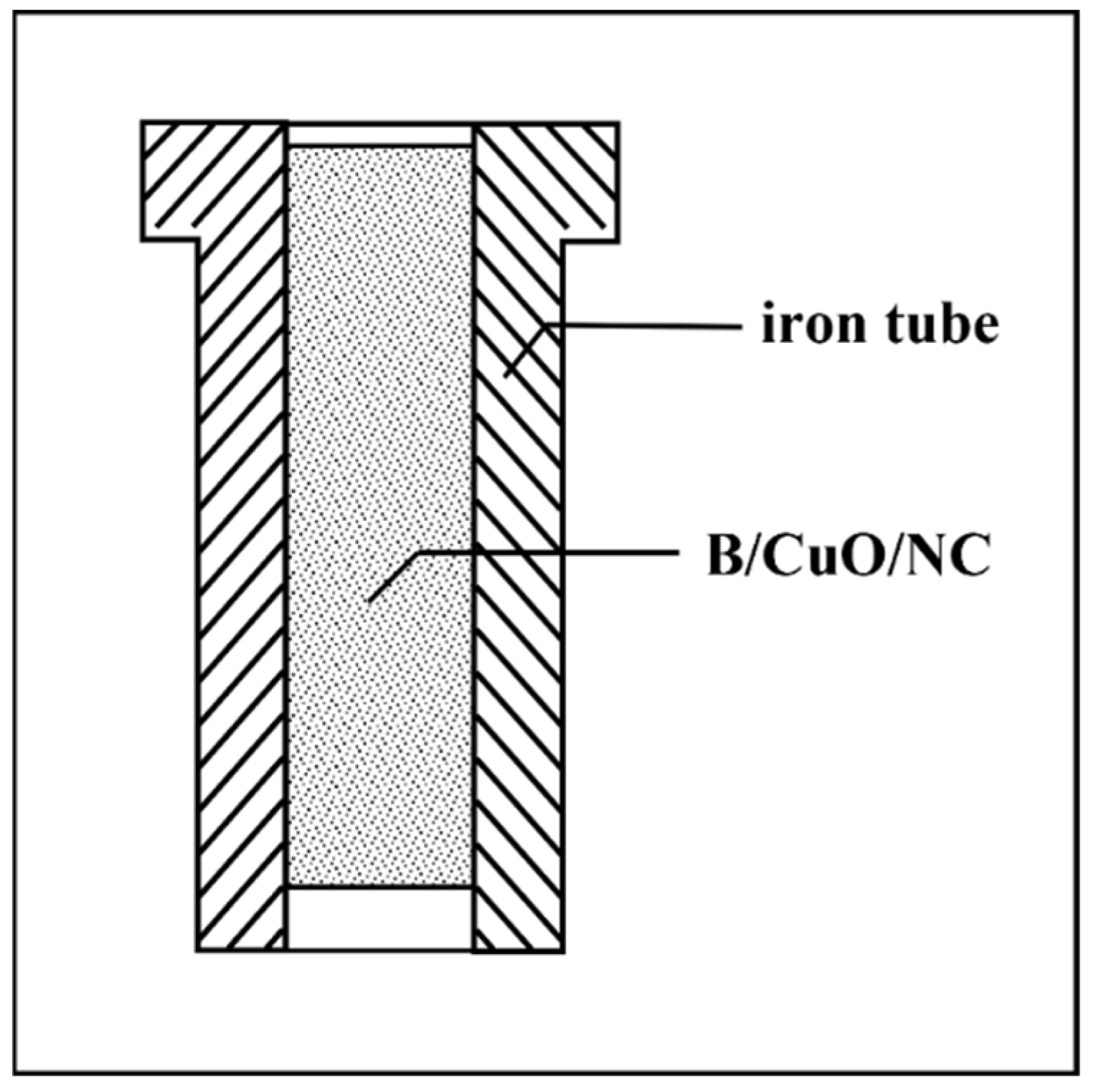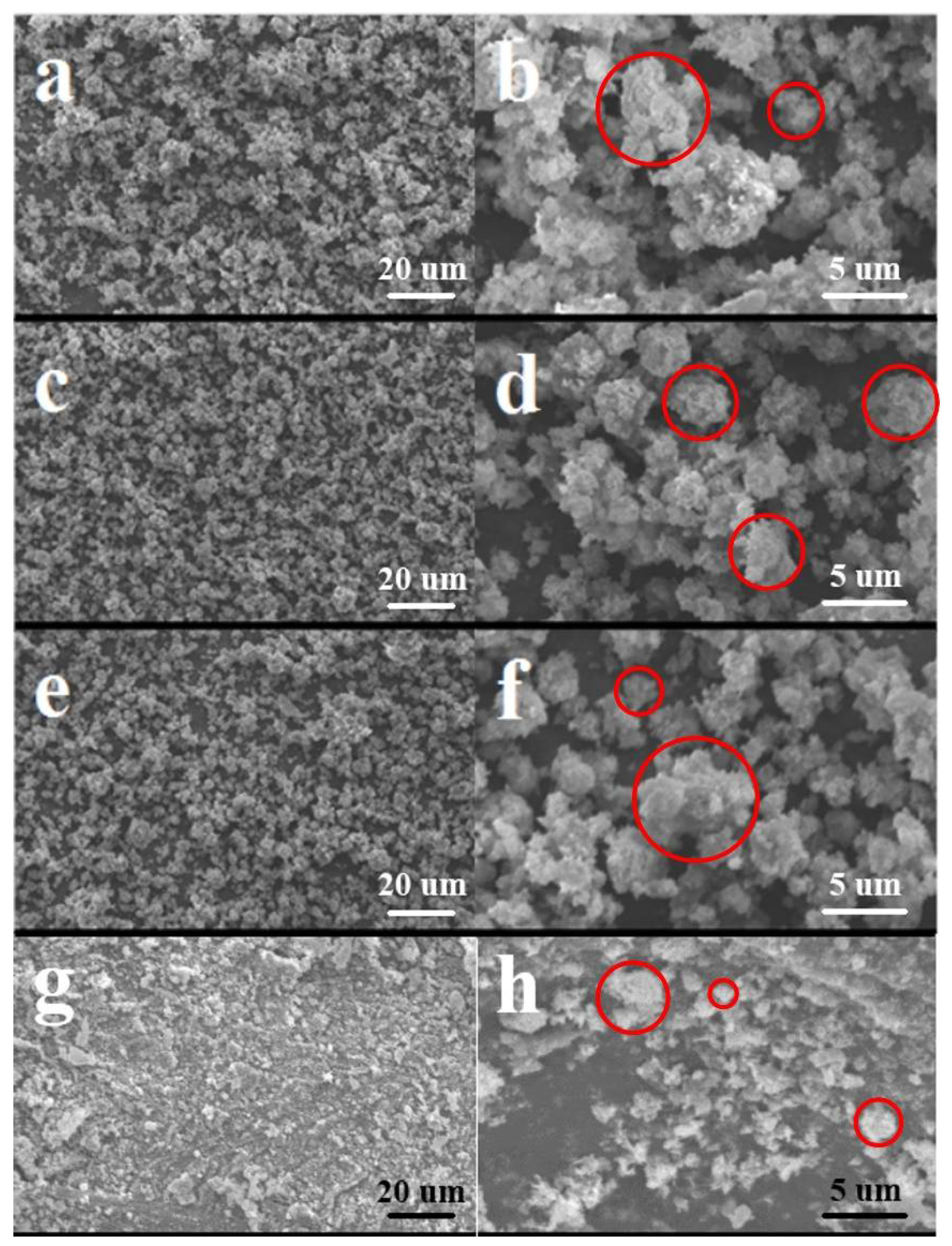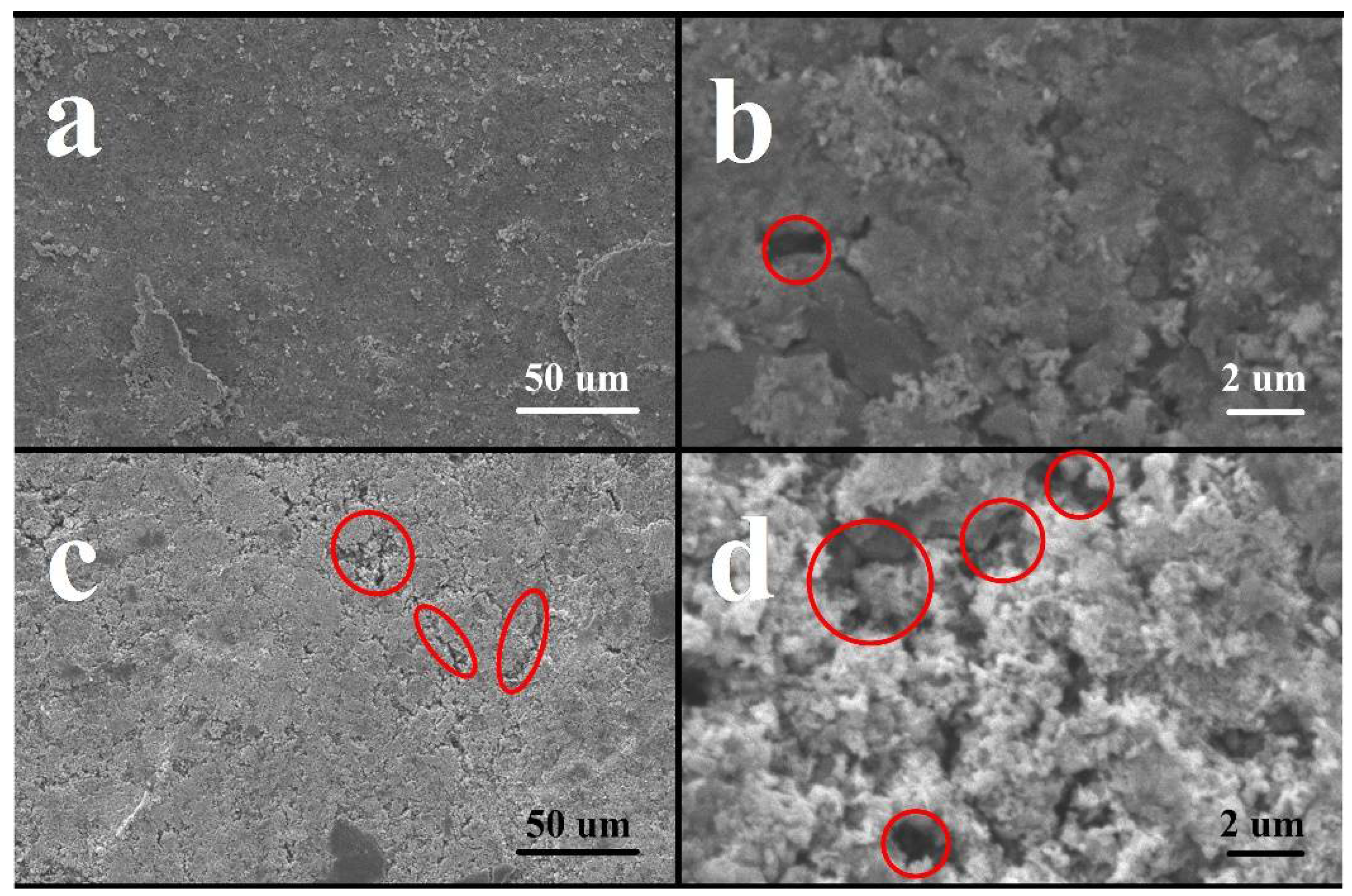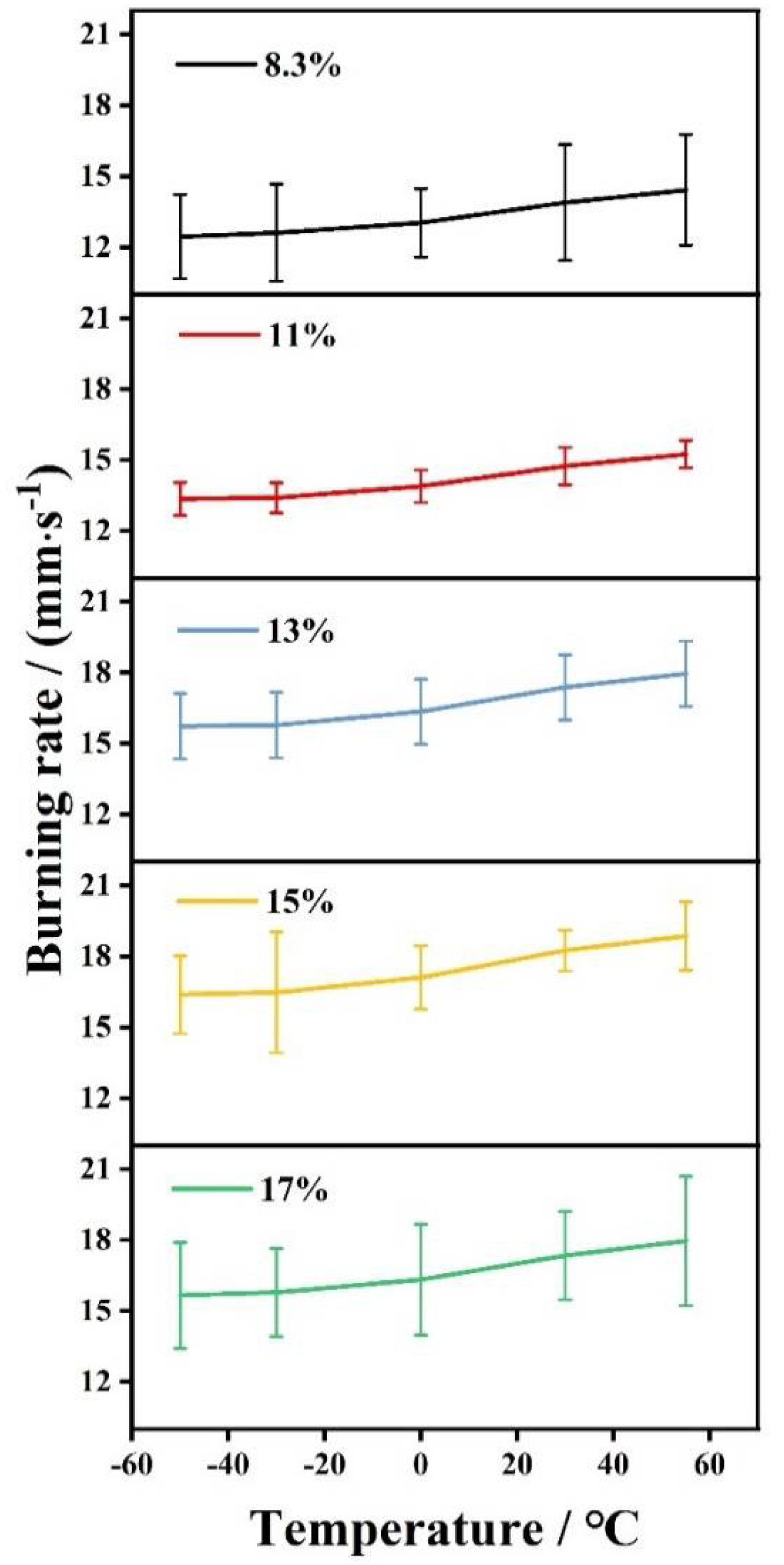Ignition and Combustion Characteristics of B/NC/CuO Thermite Microparticles
Abstract
:1. Introduction
2. Experimental Section
2.1. Materials
2.2. Physical Ball Milling of B/NC/CuO Thermite
2.3. Electrospray of B/NC/CuO Thermite
2.4. Preparation of B/NC/CuO Thermite Device
2.5. Characterization of B/NC/CuO Thermite
2.5.1. Surface Morphology
2.5.2. Combustion Performance of B/NC/CuO Thermite
2.5.3. Laser Ignition Energy of B/NC/CuO Thermite
2.5.4. Thermal Performance
3. Results and Discussion
3.1. Morphology of B/NC/CuO
3.2. Effects of B Content on the Burning Rate of B/NC/CuO Thermite
3.3. Effects of Temperature on the Burning Rate of B/NC/CuO Thermite
3.4. Effects of Ambient Pressure on the Burning Rate of B(11%)/NC/CuO Thermite
3.5. Laser Ignition Energy of B(11%)/NC/CuO Thermite
3.6. Thermal Properties of B/NC/CuO Thermite
4. Conclusions
Author Contributions
Funding
Institutional Review Board Statement
Informed Consent Statement
Data Availability Statement
Conflicts of Interest
References
- Koch, E.C.; Knapp, S. Thermites-Versatile Materials. Propellants Explos. Pyrotech. 2019, 44, 7. [Google Scholar]
- Rossi, C.; Zhang, K.; Estève, D.; Alphonse, P.; Tailhades, P.; Vahlas, C. Nanoenergetic Materials for MEMS: A Review. J. Microelectromech. Syst. 2007, 4, 919–931. [Google Scholar]
- Monogarov, K.A.; Meerov, D.B.; Frolov, Y.V.; Pivkina, A.N. Combustion Features of Nanothermites in Pyrotechnic Heaters. Russ. J. Phys. Chem. B 2019, 13, 610–614. [Google Scholar]
- Shi, H.; Hu, Y.; Li, T.; Tao, Z.; Li, X.; Wu, J.; Murphy, A.B.; Qiu, A. Detonation of a Nitromethane-based Energetic Mixture Driven by Electrical Wire Explosion. J. Phys. D Appl. Phys. 2021, 55, 5. [Google Scholar] [CrossRef]
- Mursalat, M.; Huang, C.; Julien, B.; Schoenitz, M.; Esteve, A.; Rossi, C.; Dreizin, E.L. Low-Temperature Exothermic Reactions in Al/CuO Nanothermites Producing Copper Nanodots and Accelerating Combustion. ACS Appl. Nano Mater. 2021, 4, 3811–3820. [Google Scholar]
- Yang, G.Y.H.; Li, X.; Bao, H.; Yang, Y.; Guo, X.; Qiao, Z.; Li, X. Facile Synthesis of High Tightly Ordered Al/CuO Core-Shell Nanowire Arrays and the Effect of Surface Density on Combustion. J. Alloys Compd. 2021, 877, 160025. [Google Scholar]
- Li, S.; Huang, C.; Chen, J.; Bai, S.; Tang, Y.; Liu, X. Formation of Dispersed Al/MoO3 Interfaces and their Effect on the Energy Release Performance of Al-Ni Composites. Intermetallics 2022, 141, 107409. [Google Scholar]
- Sandall, E.T.; Kalman, J.; Quigley, J.N.; Munro, S.; Hedman, T.D. A Study of Solid Ramjet Fuel containing Boron-Magnesium Mixtures. Propuls. Power Res. 2017, 6, 243–252. [Google Scholar]
- Yuan, J.; Liu, J.; Zhang, L.; Xu, P.; Chen, D.; Yang, W. Combustion and Agglomeration Characteristics of Boron Particles in Boron-containing Fuel-rich Propellant. Combust. Flame 2021, 232, 111551. [Google Scholar]
- Rashkovskiy, S.A. Boron Particle Agglomeration and Formation of Solid Residues in Combustion of Boron-containing Solid Propellants. In Proceedings of the 11th International Conference Aerophysics and Physics Mechanics of Classical and Qunatum Systems (APHM-2017), Moscow, Russia, 21–24 November 2017; p. 1009. [Google Scholar]
- Gottfried, J.L.; Wainwright, E.R.; Huang, S.; Jiang, Y.; Zheng, X. Probing Boron Thermite Energy Release at Rapid Heating Rates. Combust. Flame 2021, 231, 111491. [Google Scholar]
- Huang, S.; Deng, S.; Jiang, Y.; Zheng, X. Experimental Effective Metal Oxides to Enhance Boron Combustion. Combust. Flame 2019, 205, 278–285. [Google Scholar]
- Liu, T.; Chen, X.; Xu, H.; Han, A.; Ye, M.; Pan, G. Preparation and Properties of Boron-Based Nano-B/NiO Thermite. Propellants Explos. Pyrotech. 2015, 40, 873–879. [Google Scholar]
- Liu, T.; Chen, X.; Han, A.; Ye, M.; Zhang, S. Preparation and Properties of Boron-Based Nano-B/CuO Thermite. IV Sino-Russ. ASRTUM Symp. Adv. Mater. Process. Technol. 2016, 2016, 95–102. [Google Scholar] [CrossRef]
- Xi, J.; Liu, J.; Wang, Y.; Hu, Y.; Zhang, Y.; Zhou, J. Metal Oxides as Catalysts for Boron Oxidation. J. Propul. Power 2014, 30, 47–53. [Google Scholar]
- Wang, X.; Wu, T.; Wang, H. Boron Ignition and Combustion with Doped δ-Bi2O3: Bond Energy/Oxygen Vacancy Relationships. Combust. Flame 2018, 197, 127–133. [Google Scholar]
- Dai, J.; Xu, J.; Wang, F.; Tai, Y.; Shen, Y.; Shen, R.; Ye, Y. Facile formation of nitrocellulose-coated Al/Bi2O3 nanothermites with excellent energy output and improved electrostatic discharge safety. Mater. Des. 2018, 143, 93–103. [Google Scholar]
- Liu, P.; Li, X.; Cheng, L.; Zhu, X.; Li, Y.; Song, D. Preparation and characterization of n-Al/FeF3 nanothermite. Chem. Eng. J. 2018, 331, 850–855. [Google Scholar]
- Mursalat, M.; Schoenitz, M.; Dreizin, E.L. Effect of premilling Al and CuO in acetonitrile on properties of Al·CuO thermites prepared by arrested reactive milling. Combust. Flame 2020, 214, 57–64. [Google Scholar]
- Li, L.; Chen, Y.; Behan, G.; Zhang, H.; Petravic, M.; Glushenkov, A.M. Large-scale mechanical peeling of boron nitride nanosheets by low-energy ball milling. J. Mater. Chem. 2011, 21, 11862–11866. [Google Scholar]
- Liu, X.; Chintersingh, K.L.; Schoenitz, M.; Dreizin, E.L. Reactive composite boron–magnesium powders prepared by mechanical milling. J. Propul. Power 2017, 34, 787–794. [Google Scholar]
- Chen, L.; Ru, C.; Zhang, H.; Zhang, Y.; Chi, Z.; Wang, H. Assembling Hybrid Energetic Materials with Controllable Interfacial Microstructures by Electrospray. ACS Omega 2021, 6, 16816–16825. [Google Scholar] [PubMed]
- Dai, J.; Wang, C.; Wang, Y.; Xu, W. From Nanoparticles to on-chip 3D Nanothermite: Electrospray Deposition of Reactive Al/CuO@NC onto Semiconductor Bridge and its Application for Rapid Ignition. Nanotechnology 2020, 31, 195712. [Google Scholar] [PubMed]
- Husain, O.; Lau, W.; Edirisinghe, M.; Parhizkar, M. Investigating the Particle to Fiber Transition Threshold during Electrohydrodynamic Atomization of a Polymer Solution. Mat. Sci. Eng. C-Mater. 2016, 65, 240–250. [Google Scholar]
- Ali, A.; Zaman, A.; Sayed, E.; Evans, D.; Morgan, S.; Samwell, C. Electrohydrodynamic Atomisation Driven Design and Engineering of Opportunistic Particulate Systems for Applications in Drug Delivery, Therapeutics and Pharmaceutics. Adv. Drug Deliv. Rev. 2021, 176, 113788. [Google Scholar] [PubMed]
- Nakaso, K.; Han, B.; Ahn, K.H.; Choi, M.; Okuyama, K. Synthesis of Non-agglomerated Nanoparticles by an Electrospray Assisted Chemical Vapor Deposition (ES-CVD) Method. J. Aerosol. Sci. 2003, 34, 869–881. [Google Scholar]
- Wang, H.; Jian, G.; Yan, S.; Jeffery, B.; Huang, C.; Zachariah, R. Electrospray Formation of Gelled Nano-Aluminum Microspheres with Superior Reactivity. ACS Appl. Mater. Inter. 2013, 5, 6797–6801. [Google Scholar]
- Wang, H.; Guo, T.; Ding, W.; Yao, M.; Feng, X.; Song, J. The Effect of CuO on the Thermal Behavior of the High-Energy Combustion Agent of the Al/MnO2 System. Adv. Mater. Sci. Eng. 2019, 2019, 4536268. [Google Scholar] [CrossRef] [Green Version]
- Kim, S.B.; Kim, K.J.; Cho, M.H.; Kim, J.H.; Kim, K.T.; Kim, S.H. Micro- and Nanoscale Energetic Materials as Effective Heat Energy Sources for Enhanced Gas Generators. ACS Appl. Mater. Interfaces 2016, 8, 9405–9412. [Google Scholar]
- Cheng, L.; Yang, H.; Yang, Y.; Li, Y.; Meng, Y.; Li, Y. Preparation of B/Nitrocellulose/Fe Particles and their Effect on the Performance of an Ammonium Perchlorate Propellant. Combust. Flame 2020, 211, 456–464. [Google Scholar]








| Samples | B (wt%) | CuO (wt%) | NC (wt%) |
|---|---|---|---|
| #1 | 8.3 | 88.7 | 3 |
| #2 | 11 | 86 | 3 |
| #3 | 13 | 87 | 3 |
| #4 | 15 | 82 | 3 |
| #5 | 17 | 80 | 3 |
| No. | B Content (%) | The Burning Rate of Electrosprayed | The Burning Rate of Ball-Milled | ||
|---|---|---|---|---|---|
| Average (mm·s−1) | Standard Deviation | Average (mm·s−1) | Standard Deviation | ||
| 1 | 8.7 | 13.8 | 1.78 | 26.8 | 4.29 |
| 2 | 11 | 13.6 | 0.32 | 27.2 | 0.47 |
| 3 | 13 | 16.1 | 0.91 | 27.6 | 2.15 |
| 4 | 15 | 18.9 | 0.36 | 35.8 | 2.93 |
| 5 | 17 | 18.0 | 1.50 | 31.8 | 1.37 |
| Sample | 1 | 2 | 3 | 4 | 5 |
|---|---|---|---|---|---|
| Range/(mm·s−1) | 1.97 | 1.89 | 2.22 | 2.48 | 2.3 |
| Pressure/MPa | Burning Rate u1/(mm/s) | Burning Rate u2/(mm/s) | Burning Rate u3/(mm/s) | Average u/(mm/s) | Standard Deviation/(mm/s) |
|---|---|---|---|---|---|
| 0.1 | 13.58 | 13.20 | 13.89 | 13.56 | 0.35 |
| 0.07 | 13.65 | 12.48 | 13.85 | 13.33 | 0.74 |
| 0.05 | 12.54 | 14.27 | 13.46 | 13.42 | 0.86 |
| 0.02 | 12.66 | 14.16 | 12.51 | 13.11 | 0.91 |
| Energy (mJ) | 90 | 80 | 70 | 69.5 | 65 | 60 | 50 | 45 | 44.5 | 40 |
|---|---|---|---|---|---|---|---|---|---|---|
| Ball-milled | √ | √ | √ | × | × | × | × | × | × | × |
| Electrosprayed | √ | √ | √ | √ | √ | √ | √ | √ | × | × |
| Sample | Onset Temperature (°C) | Peak Temperature (°C) | Heat Release (mW/mg) |
|---|---|---|---|
| 1 | 616.5 | 641.6 | 657.1 |
| 2 | 613.3 | 635.6 | 998 |
| 3 | 613.7 | 636.4 | 845 |
| 4 | 611.5 | 633.3 | 829 |
| 5 | 614.2 | 636.5 | 916 |
Publisher’s Note: MDPI stays neutral with regard to jurisdictional claims in published maps and institutional affiliations. |
© 2022 by the authors. Licensee MDPI, Basel, Switzerland. This article is an open access article distributed under the terms and conditions of the Creative Commons Attribution (CC BY) license (https://creativecommons.org/licenses/by/4.0/).
Share and Cite
Wang, J.; Yang, H.; Cheng, L.; Gao, P.; Li, Y.; Song, D. Ignition and Combustion Characteristics of B/NC/CuO Thermite Microparticles. Metals 2022, 12, 1419. https://doi.org/10.3390/met12091419
Wang J, Yang H, Cheng L, Gao P, Li Y, Song D. Ignition and Combustion Characteristics of B/NC/CuO Thermite Microparticles. Metals. 2022; 12(9):1419. https://doi.org/10.3390/met12091419
Chicago/Turabian StyleWang, Jie, Hongtao Yang, Long Cheng, Pin Gao, Yanchun Li, and Dongming Song. 2022. "Ignition and Combustion Characteristics of B/NC/CuO Thermite Microparticles" Metals 12, no. 9: 1419. https://doi.org/10.3390/met12091419
APA StyleWang, J., Yang, H., Cheng, L., Gao, P., Li, Y., & Song, D. (2022). Ignition and Combustion Characteristics of B/NC/CuO Thermite Microparticles. Metals, 12(9), 1419. https://doi.org/10.3390/met12091419






